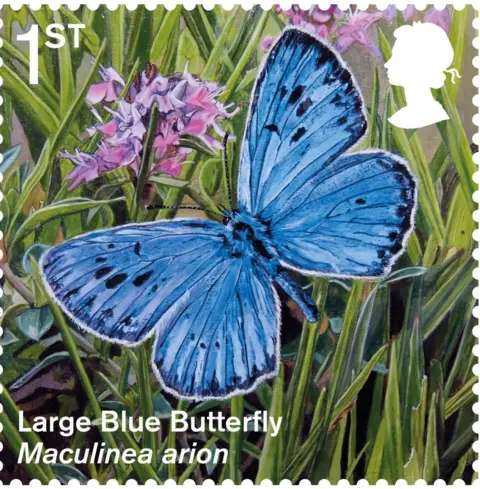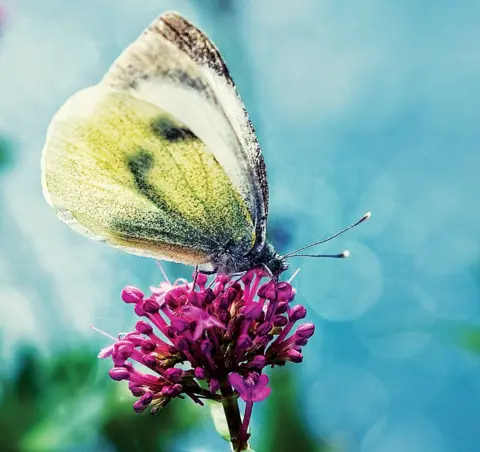Reality Check: Are butterflies getting rarer?
 Getty Images
Getty ImagesIt's been claimed that butterfly populations in the UK are falling rapidly. Do the figures back this up?
Their names are as varied and colourful as their wings.
The Duke of Burgundy, the Lulworth skipper, the chalk hill blue, the painted lady and the small pearl-bordered fritillary are among the 59 species of butterfly regularly found in the UK.
But, adored as they are, it's often claimed that the UK's butterflies are in trouble. Climate change, habitat destruction and hunting/collecting have all been blamed.
The naturalist Chris Packham recently tweeted his concern.
Allow X content?
The statistics support his observation.
Government figures suggest that, since 1976, "habitat specialist" butterflies - the ones that tend not to fly far from their favoured landscapes, such as heathland or chalkland - have declined by 77%.
"Wider countryside" species - the ones that are better able to move around and adapt to different environments - have declined by 46% over the same period.
"It's worrying," says Tom Brereton, head of monitoring for the charity Butterfly Conservation. "When I started doing this, the concern was mainly about habitat specialists, but now all types seem to be struggling. We don't fully understand why that's happening."
The government's figures are partly based on the UK Butterfly Monitoring Scheme (UKBSM), involving hundreds of volunteers looking at how many of each species pass through monitoring sites around the UK.
In 2017, it found that two - the grayling and the grizzled skipper - had their worst year on record, declining by 6% and 9% respectively.
 Royal mail
Royal mailAccording to the UKBSM, the largest declines for any species over the long haul were for the white-letter hairstreak (down by 93% since 1976) and the heath fritillary (down 91% since its numbers were first recorded in 1981).
Since 1976, 35 of the 57 species monitored by the UKBSM have declined.
But 22 species of butterfly are now seen more frequently than when the surveys began. Sightings of the silver-spotted skipper are up by 566% since it was first recorded in 1979, while the large heath is up by 408% since its first recording in 1990.
However, the species whose appearances have increased the most is the large blue.
It was declared extinct in the UK in 1979, but conservationists reintroduced it during the early 1980s at some sites in south-west England, using eggs imported from Sweden. As of last year, its numbers were up more than 1,000% on its 1983 level.
To celebrate, Royal Mail created a large blue butterfly stamp as part of a series showing conservation success stories earlier this year.

How to encourage butterflies into your garden
- Grow grass long and plant plenty of flowers
- Leave fallen fruit under trees for them to feed on
- Avoid using pesticides
- Plant butterfly larval food plants, and allow wild plants such as thistles and stinging nettles to grow
- Source: Royal Horticultural Society/Butterfly Conservation

Butterfly numbers in the UK may have fallen, but the range of species has not.
If you're a keen watcher of the insects -of which there are about 17,500 species globally - the south of England is a good place to go. According to the UK Butterflies group, from 2000 to 2009, some parts of this region - including Hampshire, where Mr Packham lives - contained between 43 and 46 species per square km. In some areas of Scotland, Northern Ireland and south-west England, the figure was as low as 0 to 2 species.
But according to Mr Brereton, climate change means this is altering, as some types of butterfly head north, attracted by warmer temperatures.
 Getty Images
Getty ImagesMeanwhile, one hazard that butterflies living near humans used to face has dwindled. Hunting them with nets during the summer was once a popular hobby, but legal protections - and awareness of the need for conservation - have increased.
In England, Scotland and Wales it's a criminal offence to kill or be in possession of some rare species of butterfly. In Northern Ireland and the Isle of Man similar measures are in place to protect certain species.
"The situation has changed for sure," says Peter Eeles, founder of UK Butterflies. "When butterflies were everywhere, children collected them in nets, but that's not the case any more. And, with the rise of digital photography, you can get lovely pictures without having to capture or kill anything."
So, what of Chris Packham's observation?
"You get something at this year that we call the 'June gap'," says Mr Eeles. "It's the period between many species' first and second broods of the year, when things go a bit quiet. Maybe that's why Chris Packham found nothing in his garden.
"But, with the recent good weather, we should be in for much more sightings of some really beautiful butterflies, starting right about now."



